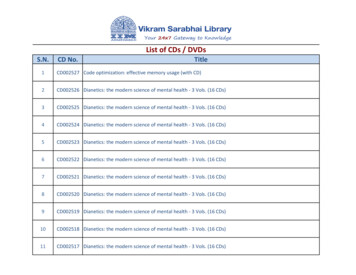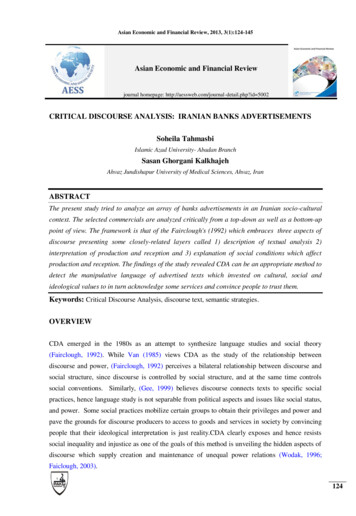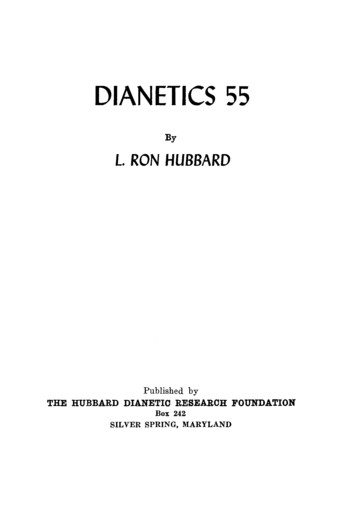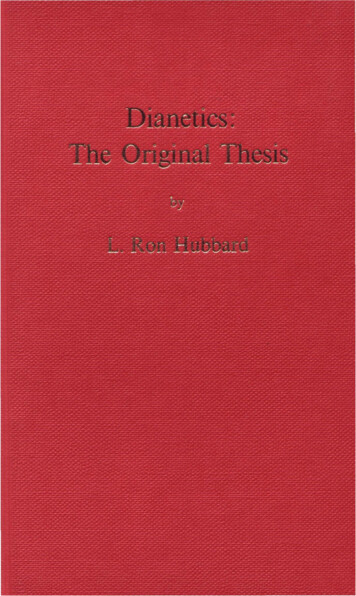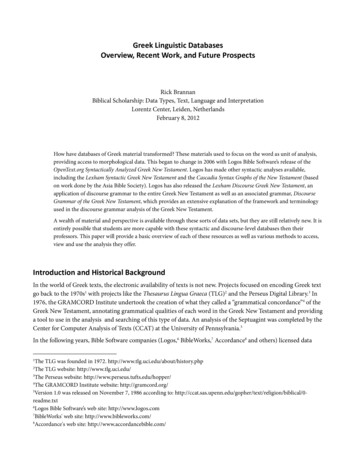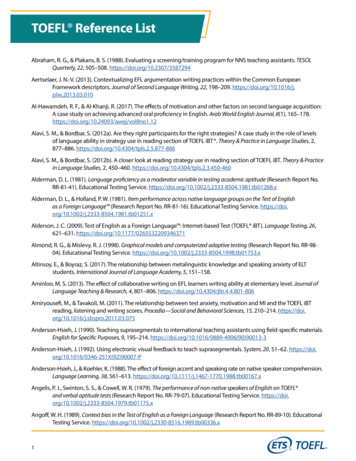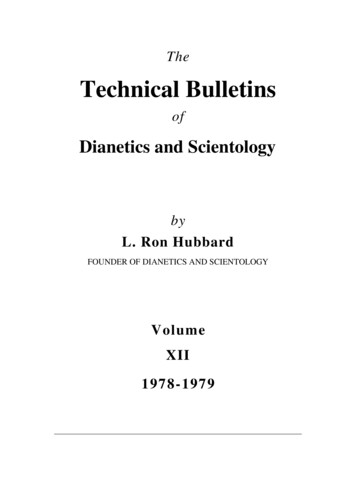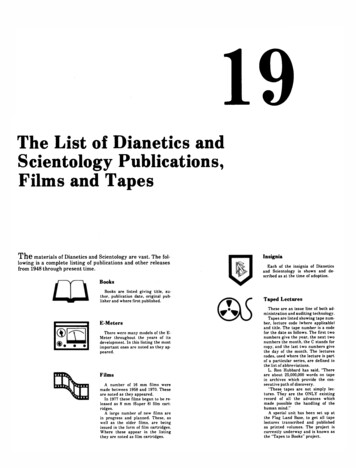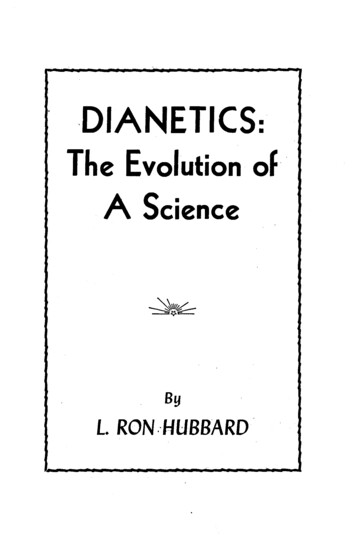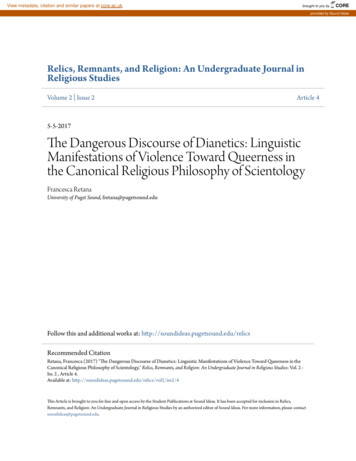
Transcription
View metadata, citation and similar papers at core.ac.ukbrought to you byCOREprovided by Sound IdeasRelics, Remnants, and Religion: An Undergraduate Journal inReligious StudiesVolume 2 Issue 2Article 45-5-2017The Dangerous Discourse of Dianetics: LinguisticManifestations of Violence Toward Queerness inthe Canonical Religious Philosophy of ScientologyFrancesca RetanaUniversity of Puget Sound, fretana@pugetsound.eduFollow this and additional works at: http://soundideas.pugetsound.edu/relicsRecommended CitationRetana, Francesca (2017) "The Dangerous Discourse of Dianetics: Linguistic Manifestations of Violence Toward Queerness in theCanonical Religious Philosophy of Scientology," Relics, Remnants, and Religion: An Undergraduate Journal in Religious Studies: Vol. 2 :Iss. 2 , Article 4.Available at: 4This Article is brought to you for free and open access by the Student Publications at Sound Ideas. It has been accepted for inclusion in Relics,Remnants, and Religion: An Undergraduate Journal in Religious Studies by an authorized editor of Sound Ideas. For more information, please contactsoundideas@pugetsound.edu.
Page 1 of 45The Dangerous Discourse of Dianetics:Linguistic Manifestations of Violence Toward Queerness in the Canonical Religious Philosophyof ScientologyI. Uncovering the Anti-Queer Sentiment in the Dianetic PerspectiveAt present, there is a groundswell of public sensational interest in the subject ofScientology; and, in fact, in the time since I began this research paper, a nine-episodedocumentary series has premiered and reached finale on A&E titled “Scientology and theAftermath”— a personal project hosted by sitcom celebrity, ex-Scientologist, and author ofTroublemaker: Surviving Hollywood and Scientology, Leah Remini.1 I could not begin toenumerate the myriad exposés/memoirs of ex-Scientologists that have been published in recentyears nor could I emphasize enough the rampant conspiracy theories that are at the disposal ofany curious mind on what many have termed “the cult” of Scientology. Be forewarned that asimple internet search of “Scientology” plus “Violence” will surely coax one down the rabbithole of research. I anticipate, however, that a conjunction of the terms “Scientology” and“Homophobia” might prove exceedingly enlightening.It is beyond the scope of this research paper to analyze the multiple accounts that haveemerged across numerous platforms (both digital and print via formal and informal channels ofpublication) that detail instances of personal and physical violence committed at the behest ofScientology. Rather, what I set out to do in the limited space granted is to interrogate a verydistinct and incisive form of violence perpetrated against a particular category of marginalizedidentities. By utilizing passages from trademarked canonical texts of Scientology as primarysource material, I will investigate how this form of violence is authenticated and realized. I amLeah Remini: Scientology and the Aftermath. “Disconnection.” Episode 1. Produced by Leah Remini, EliHolzman, Aaron Saidman, Alex Weresow. A&E, Nov 29, 2016-Jan 17, 2017 ; Remini, Leah, and Paley, Rebecca.Troublemaker : Surviving Hollywood and Scientology. First ed. New York: Ballantine Books, 2015.1
Page 2 of 45only capable of providing a contextual glimpse into a pervasive violent reality as it intersectsspecifically with queerness— in a way that has been consistently invisible to the outsider, andmore often than not, the insider as well.Typical interpretations and expressions of violence can be understood as physical harmaccomplished through brute force that define a clear perpetrator and victim.2 To be sure, suchinstances are rampant and well-evidenced within the formal institution of Scientology. I wouldlike to emphasize that I fully recognize the existence of such occurrences and have become wellversed in the structures that carry them out through research and presentation. If traditional actsof violence as demonstrations of physical force in Scientology are of greater interest to the readerthan the more subtle or covert forms of violence that this paper will explore, I would invite theinquirer to review the glossary attached to this paper.With the intention of preciseness in the following investigation, I have limited mydiscussion to the realm of verbal violence as it exists on the documented linguistic level. Suchverbal violence is perpetually deployed in the copying and consumption of L. Ron Hubbard’s(the founder of Dianetics and Scientology) writings—remaining remarkably static over the pastsixty-seven years. To reiterate, I understand that by concentrating in linguistic properties ofviolence as they manifest through rhetorical devices, millions of forms of atrocious and visibleinstances of violence are going without mention.3 I do not wish to diminish the value of currentdiscussion surrounding corporeal and visible forms of violence, however it seems crucial that ascholarly discussion—as opposed to scandalized and sensationalized— be prompted to validatethe physiological after-effects that frequently accompany linguistic violence for those whom are2Class notes, REL 410, Professor Greta Austin. Sep 1, 2016.Gay, William C. “Exposing and Overcoming Linguistic Alienation and Linguistic Violence,” Philosophy & SocialCriticism, vol. 23 no. 2/3. (California: SAGE Publications, 1998): 137.3
Page 3 of 45victims. While I am aware of the preponderance and consequences of physical injury that haveattracted media attention as of late, I set out to demonstrate that the psychological harm incurredthrough overt and covert levels of language are equally as devastating and deleterious to thetargeted sufferer. Then, the objective of the following paper is to analyze the ways in whichlinguistic violence is erected to target the queer community through rabid homophobic rhetoricencountered in the foundational, or canonical, texts of Scientology as an applied religiousphilosophy.I will argue that the expression of sexuality is violently repressed by the deployment andmanipulation of discriminatory language included in Scientology’s canonical texts thatintroduced the technological philosophy of Dianetics. L. Ron Hubbard’s outlined path to spiritualsuperiority in his invented, new and alternative religious movement is enduringly plagued byprejudice. The narratives and testimonies of queer and ally defectors/apostates from theinstitutionalized Church of Scientology include their understanding of the Second Dynamic (orSex Dynamic) and the ways in which a Dianetic framework of human existence is brimmingwith unbridled bigotry with the intent to indoctrinate.4 I will seek to prove that L. Ron Hubbardhas equipped Scientology with normalized master tools of manipulation that championcompulsive heteronormativity and in turn diminish, if not erase, autonomy and agency as theyrelate to the expression of sexuality and gender nonconformity.The emergence of individuality is seriously crippled by the distortion of identitydevelopment as presented in L. Ron Hubbard’s Dianetics: The Modern Science of Mental Health(A Handbook of Dianetic Therapy), the foundational text of Scientology, as well as in his followup books Science of Survival: Prediction of Human Behavior and Handbook for Preclears.4Jolly, Don. "Sexuality in Three Ex-Scientology Narratives." Alternative Spirituality and Religion Review 6.1(2015): 51.
Page 4 of 45Dianetics: The Modern Science of Mental Health was originally published in 1950 and spawnedthe religious movement that would soon materialize as the Church of Scientology in 1954.5 Theapplication of Dianetics, as a technological philosophy, was extended upon in Hubbard’s 1951Science of Survival: Prediction of Human Behavior and Handbook for Preclears. I selected thesetexts in particular because they make explicit reference to homosexuality and, in a more moderncomprehension, this would include non-normative sexual identities or expressions. In myresearch, I scoured through three different print editions of Dianetics: The Modern Science ofMental Health, and my findings were as remarkable in their consistency as they were alarming.In the last two decades, the Church has pushed a flimsy agenda of acceptance andinclusivity.6 While currently disseminated material by the Church is guised as more inclusive ofthe queer community, the posthumous versions of the above mentioned Hubbard texts remainunchanged regarding the topics of sexual deviancy and/or perversion. It is clear that theprecedent was set in 1950 and the Church has not rid itself of a violent anti-queer sentiment. Inactuality, there is nothing subtle or covert about this position as can be demonstrated byflagrantly homophobic rhetoric and conscious components of Scientology configured byHubbard’s wish to eradicate what he perceived to be a psychosomatic illness of “sexualperversion.”7 This is further exacerbated by the unwillingness of any devout Scientologist tochallenge, denounce, or amend the conclusions of their glorified charismatic founder.It seems only fair that I acknowledge and differentiate between variant manifestations ofScientology. Scientology as a formal and official institution is referred to as the Church of5Urban, Hugh B. The Church of Scientology : A History of a New Religion. Princeton: Princeton University Press,2011. 53.6Rinder, Mike, “Scientology Homophobia,” Something Can Be Done About It (blog). Oct 10, mophobia/7Hubbard, L. Ron. Dianetics : The Modern Science of Mental Health. Los Angeles: Church of Scientology ofCalifornia, Publications Organization United States, 1950.
Page 5 of 45Scientology (in previous pages, I have referred to it simply as “The Church”). The Church(currently fronted by David Miscavige) is the most dominant embodiment of Scientology andseeks to keep strict regulation on the dissemination of Dianetic materials and track globalmembership. However, Scientology as an applied religious philosophy does not occur solely inthis context. Independent Scientologists operating in what is commonly referred to as the “FreeZone” still prescribe to the techniques and doctrine of Scientology outside of the conventionalestablishment.8 Regardless of the context of application, the unifying component of allScientology practitioners is the glorification of L. Ron Hubbard (occasionally abbreviated as“LRH” from here forth) and the reliance on his book Dianetics. The acceptance and applicationof Dianetics as the authoritative origin of behavior will serve as the focus of the paper. As anaside, there is great contention in how many self-identified Scientologists there are today—theinstitution claims upwards of eight million while various polls have offered a generousestimation of just forty-thousand worldwide.9 This confusion may arise in that the organizationinflates these numbers with the sales of the hundreds of books, seminars, lectures, and coursesauthored or created by LRH that it pitches to the curious inquirer. Essentially, anyone who hashad any initial contact with the Church is subject to getting factored in to this number.10I am not making an attack on the institutionalized Church of Scientology nor on thosewho identify as Scientologists but do not claim direct affiliation with the Church. To extend thisidea even further, I am not passing direct judgment on the many who adhere to the philosophy8Tuxen Rubin, Elisabeth. "Disaffiliation Among Scientologists; A Sociological Study of Post Apostasy Behaviourand Attitudes.” International Journal for the Study of New Religions 2, no. 2 (2011): 216.9Ortega, Tony, “Scientologists: How Many Of Them Are There, Anyway?” The Village Voice, July 4, 2011 r, Mike, “10 Million Scientologists – Where Are They?” Something Can Be Done About It (blog). Nov 9,2014. ogists-where-are-they/
Page 6 of 45and approaches presented in Dianetics as a way of life, but wouldn’t call themselves“Scientologists.”11 Membership not withstanding, I am scrutinizing L. Ron Hubbard’sauthoritative fundamental Dianetics Handbook as well as his postliminary literature that havesurely been influential to all factions listed above. These texts are likely to frame the perceptionsof LRH’s most ardent supporters today, as they have operated to covertly yet coercively informtheir understanding of humanity. I have not conducted any ethnographic research nor have Ispoken first-hand to any Scientologists or ex-Scientologists to confirm this hypothesis; for this, Irely solely upon critical memoir. Thus, my paper is exploratory, interpretive, and comparative inapproach. I do not wish to further engage in debate, speculation or conjecture on the nature ofthis particular new religious movement as either an authentic religion or an illegitimate cult— Ionly wish to reveal the inherent homophobic and anti-queer rhetoric in the writings of itsfounder. The following section is dedicated to the linguistic violence inherent in my primarysources.II. Dangerous Declarations of Inferiority Substantiated in the SourceA. Dianetics: The Modern Science of Mental HealthDianetics is confusingly referred to as “Book One” by Scientologists and Dianeticists,although technically it was the third book in the chronological sequence of publishing (May1950) according to Scientology’s Materials Guide Chart.12 To be clear, Dianetics is recognizedas the most formal compilation of Hubbard’s interpretation of human behavior, marking the endof his career as a prolific writer for pulp magazines predominantly of the science fiction genre.11Tuxen Rubin, Elisabeth. "Disaffiliation Among Scientologists; A Sociological Study of Post Apostasy Behaviourand Attitudes.” International Journal for the Study of New Religions 2, no. 2 (2011): 204.12Official Church of Scientology. “DIANETICS IN THE 21ST CENTURY.” html
Page 7 of 45Dianetics, as Hubbard intended, is "the study of human behavior for the purpose of discoveringand removing the sources of aberration” and, once in print form, Dianetics launched themovement that would soon define itself as a religion four years later.13 Supposedly, this bookpresented Hubbard’s twelve years of laborious research and introduced his principles regardingthe "reactive mind" and the "dynamic principle of existence.”14 Dianetics alleges that theapplication of its technologies will bring about unprecedented therapeutic benefit; naturally, itsadvent alarmed the professional medical community because it employed superficially scientificlanguage.15A distinguishing feature of this book is that it was typed by L. Ron Hubbard, the prophet,himself and therefore could not possibly be subject to content error or extensive typographicalmistakes.16 In fact, Hubbard is claimed to have written the lengthy Dianetics (over five-hundredpages in most editions) in somewhere between three to six weeks. Although accounts vary, thisgeneral conception of Hubbard’s numinous and prodigious composition is widely accepted byScientologists.17 All other Beginning and Basic books that form the Scientology canon weredictated by a transcriptionist; therefore, it has been a common claim of the Church thatHubbard’s original concepts were misconstrued in this process.18 Conspiracy theory has madethe whole subject particularly challenging to navigate because some argue that Dianetics “hasbeen subject to continuous editing since its inception so that at present it hardly resembles the13Hubbard, L. Ron. Science of Survival. Los Angeles, Calif.: Bridge Publications, 1989. 2.Hubbard, L. Ron. Dianetics : The Modern Science of Mental Health. Los Angeles: Church of Scientology ofCalifornia, Publications Organization United States, 1950. ; Hubbard, L. Ron. Dianetics: "The Original Thesis".Sussex: Hubbard College of Scientology, 1967.15Urban, Hugh B. The Church of Scientology : A History of a New Religion. Princeton: Princeton University Press,2011. 12.16Official Church of Scientology. “GOLDEN AGE OF KNOWLEDGE FOR ETERNITY: THE BASICS.” Video,2:49:40. 17Ibid.18Ibid.14
Page 8 of 45original 1950 edition.”19 However, my own research into the rhetoric erected toward queernessin “Book One” could not attest to this charge.In 2007, it was verified by David Miscavige himself that not a single word had beenchanged in the new edition of Dianetics as it required extremely minimal editing (mostly in theinterest of aesthetics).20 I present to you a dismaying passage found completely unmodified inthe 1950, 1967, and 2007 editions of Dianetics: The Modern Science of Mental Health:The sexual pervert (and by this term dianetics, to be brief, includes any and allforms of deviation in Dynamic II such as homosexuality, lesbianism, sexualsadism, etc. and all down the catalogue of Ellis and Krafft-Ebing) is actuallyquite physically ill. Perversion as an illness has so many manifestations that itmust be spread through the entire gamut of classes from (1) to (5) above. Overdevelopment of sexual organs, underdevelopment, seminal inhibition ormagnification, etc. are found some in one pervert, some in another. And the sumof it is that the pervert is always a very ill person in one way or another, whetherhe is conscious of it or not. He is very far from culpable for his condition, but heis also so far from normal and so extremely dangerous to society that thetolerance of perversion is as thoroughly bad for society as punishment for it.Lacking proper means prior to this time, society has been caught betweentolerance and punishment, and the problem of perversion has, of course, notbeen resolved.21For context, Richard von Krafft-Ebing published works on a variety of sexual practicesand inclinations in the latter half of the nineteenth century. His conviction was such that sexualengagement not designated to accomplish procreation was undeniably perverse; further notingthat homosexuals suffered from an extreme degree of perversion because their sexual practices19Lewis, James R. Scientology. Oxford ; New York: Oxford University Press, 2009. 40.Official Church of Scientology. “GOLDEN AGE OF KNOWLEDGE FOR ETERNITY: THE BASICS.” Video,2:49:40. 21Hubbard, L. Ron. Dianetics : The Modern Science of Mental Health. Los Angeles: Church of Scientology ofCalifornia, Publications Organization United States, 1950. ; Hubbard, L. Ron. Dianetics: "The Original Thesis".Sussex: Hubbard College of Scientology, 1967. 103.20
Page 9 of 45were veritably unproductive of offspring.22 In a similar vein, Hubbard certifies the perversenature of homosexuality but takes Krafft-Ebing’s conclusion one step further by detailing theexperiential antecedents that construct said nature. Hubbard’s essential premise is that the mindis more than capable of adversely affecting the body, and when it does so, it is described as apsychosomatic condition.23 Thus, psychosomatic illnesses are physical illnesses caused by theinternal spirit—which will later be termed by Hubbard as “theta(n)”. Logically following, queeracts, inclinations, innuendo, and identities are construed as the symptoms of psychosomaticillness. To leave you with an unsettling depiction that easily surpasses Freud’s absurd rationalein his psychosexual theory, Hubbard writes:A bit off the subject here, but it can be remarked about perversion that the bestprevious explanation for it was something about girls becoming envious of Papa'spenis or boys becoming upset about that terrible thing, the vulva, which Mama wasincautious enough to show one day. It takes a great deal more than this utter tripe tomake a pervert. It is, rather, something on the order of kicking a baby's head in,running over him with a steam roller, cutting him in half with a rusty knife, boilinghim in lysol and all the while with crazy people screaming the most horrifying andunprintable things at him When it comes to throwing his second dynamic out ofbalance, what that takes is straight out of Dante and Sax Rohmer combined. Hencethe pervert, containing hundreds and hundreds of vicious engrams, has had littlechoice between being dead and being a pervert. But with an effective science tohandle the problem, a society which would continue to endure perversion and all itssad and sordid effects doesn't deserve to survive.24B. Science of Survival22Krafft-Ebing, R. Von, Rebman, F. J., and Robinson, Victor. Psychopathia Sexualis; a Medico-forensic Study.New York, N.Y.: Pioneer Publications, 1939.23Hubbard, L. Ron. Dianetics : The Modern Science of Mental Health. Los Angeles: Church of Scientology ofCalifornia, Publications Organization United States, 1950. ; Hubbard, L. Ron. Dianetics: "The Original Thesis".Sussex: Hubbard College of Scientology, 1967.24Hubbard, L. Ron. Dianetics : The Modern Science of Mental Health. Los Angeles: Church of Scientology ofCalifornia, Publications Organization United States, 1950. ; Hubbard, L. Ron. Dianetics: "The Original Thesis".Sussex: Hubbard College of Scientology, 1967, 104.
Page 10 of 45Science of Survival was first printed in June of 1951 and is considered the follow-up toHubbard's very popular Dianetics: The Modern Science of Mental Health. It is consideredstandard reference work of the Church of Scientology and is listed as fourth in publication on theMaterials Guide Chart. In original editions, Science of Survival featured the subtitle “Simplified,Faster Dianetic Techniques,” while more recent editions include the subtitle “Prediction ofHuman Behavior.”25 In the preceding historical moment, Dianetics was lauded as a scientificsubject with techniques aimed toward therapeutic results. However, in Science of Survival,Hubbard’s description of “theta” makes its first appearance; for clarity’s sake, this can beunderstood as the “life energy” or source of the “thetan”—the divine spark in each individualhuman (often interpreted as self, spirit or soul).26 This rhetoric presents an initial shift towardreligiosity and spirituality that is more or less representative of a Gnostic worldview.Hubbard authored Science of Survival during a highly suspect sojourn in pre-communistCuba.27 Science of Survival is a cumulative text filled with Dianetics terminology, and it serves akey purpose in elaborating upon and advancing Hubbard’s “discovery” (or contrivance) of TheTone Scale—his first attempt at a characterization of human behavior in a numerical graphic.Hubbard also introduces concepts that would later become key elements (or tools) ofScientology, like the formalized Hubbard Chart of Human Evaluation. This defining revelation isthe key feature of Science of Survival and effectively codifies a complete description of the ToneScale and the components of emotion.28 As depicted below, Hubbard locates homosexuality (as amanifestation of sexual perversion and deviation) on his Tone Scale at 1.1— “Covert Hostility.”25Rothstein, Mikael. "Scientology, Scripture and Sacred Tradition". In James R. Lewis, Olav Hammer. TheInvention of Sacred Tradition. Cambridge University Press. 2007. 21.26Hubbard, L. Ron. Science of Survival. Los Angeles, Calif.: Bridge Publications, 1989. 13.27Miller, Russell. Bare-Faced Messiah : The True Story of L. Ron Hubbard. (1st American ed. New York: H. Holt.)1988. 193.28Wright, Lawrence. Going Clear : Scientology, Hollywood, and the Prison of Belief. First Vintage Books ed. NewYork: Vintage Books, 2013. 97.
Page 11 of 4540.0 Serenity of Beingness30.0 Postulates22.0 Games20.0 Action8.0 Exhilaration6.0 Aesthetic4.0 Enthusiasm3.5 Cheerfulness3.3 Strong Interest3.0 Conservatism2.9 Mild Interest2.8 Contented2.6 Disinterested2.5 Boredom2.4 Monotony2.0 Antagonism1.9 Hostility1.8 Pain1.5 Anger1.4 Hate1.3 Resentment1.2 No-sympathy1.15 Unexpressed Resentment1.1 COVERT HOSTILITY***1.02 Anxiety1.0 Fear0.98 Despair0.96 Terror0.94 Numb0.9 Sympathy0.8 Propitiation0.5 Grief0.375 Making Amends0.3 Undeserving0.2 Self-abasement0.1 Victim0.07 Hopeless0.05 Apathy0.03 Useless0.01 Dying0.0 Body DeathAccording to Hubbard’s Chart of Human Evaluation, other behavioral descriptors ofCovert Hostility (1.1) include: promiscuity, perversion, sadism, use of children for sadisticpurposes, neurological illness, unexpressed resentment, no control of reason or emotion, uses slymeans of controlling others, active liability, vicious hidden intents, sex criminal, deviouslydishonest without reason, listens little; mostly to cabal, gossip or lies, incapable, capricious,irresponsible, generally always despised, and nearly always fails (among other charges).29 Belowyou will find an excerpt from Science of Survival detailing Hubbard’s stance on those individualsplaced at 2.0 or below:There are only two answers for the handling of people from 2.0 down on thetone scale, neither one of which has anything to do with reasoning with them orlistening to their justification of their acts. The first is to raise them on the tonescale by un-enturbulating some of their theta(n) by any one of the three validprocesses. The other is to dispose of them quietly and without sorrow. Addersare safe bedmates compared to people on the lower bands of the tone scale. Notall the beauty nor the handsomeness nor artificial social value nor property canatone for the vicious damage such people do to sane men and women. Thesudden and abrupt deletion of all individuals occupying the lower bands of thetone scale from the social order would result in an almost instant rise in thecultural tone and would interrupt the dwindling spiral into which any societyHubbard, L. Ron. “The Hubbard Chart of Human Evaluation.” Scientology Online Courses From the ScientologyHandbook. html29
Page 12 of 45may have entered. It is not necessary to produce a world of clears in order tohave a reasonable and worthwhile social order; it is only necessary to deletethose individuals who range from 2.0 down, either by processing them enough toget their tone level above the 2.0 line — a task which, indeed, is not very great,since the amount of processing in many cases might be under fifty hours,although it might also in others be in excess of two hundred — or simplyquarantining them from the society. A Venezuelan dictator once decided to stopleprosy. He saw that most lepers in his country were also beggars. By thesimple expedient of collecting and destroying all the beggars in Venezuela anend was put to leprosy in that country.30The sentiment in this passage is nothing less than an overt suggestion of totalextermination by deeming a particular population absolutely futile and incurable— a genocidaland rhetorical justification not unlike that employed by Adolf Hitler in Nazi Germany. WhileHubbard delineates processing as a route to deliverance, he considers the human possessing a“thetan” in a critically confused or dysfunctional state (like that of the homosexual according toHubbard) better off eliminated. Made possible by Hubbard’s newly invented construction of“theta(n),” Science of Survival now initiates a discussion on the incorrigible condition ofexistence at low levels of The Tone Scale and the consequential implausibility of salvation. Atsuch low levels, the internal theta(n) is so agitated, disturbed, and overloaded, that corporealdeath becomes the singular and inevitable outcome for the host. While the process ofrehabilitating the theta(n) is a key feature of Dianetics, it has been made markedly obvious in theabove passage that this course of action is almost entirely unattainable for certain humanclassifications— making queer identities (1.1) ostensibly ineligible.C. Handbook for PreclearsHandbook for Preclears, published in December 1951, is the sixth charted book in theScientology canon and has often been considered the second most overlooked and undervalued30Hubbard, L. Ron. Science of Survival. Los Angeles, Calif.: Bridge Publications, 1989.
Page 13 of 45in the vast L. Ron Hubbard aggregate.31 Handbook for Preclears is best described as a selfprocessing manual geared toward personal advancement. Similarly to Science of Survival,Handbook for Preclears is considered a companion guide to the seventh book referenced on theMaterials Guide Chart.32 Interestingly, Handbook for Preclears contains the first use of the word“Scientology” and it certifies the transition from Dianetics as a scientific system to beimplemented, to Scientology as a religious creed to be embodied.33Handbook for Preclears is a collection of several short didactic essays accompanied by“Fifteen Acts” of instruction. Although brief, it offers a considerable number of exercisesintended to aid an individual seeking to excel both physically and mentally. Amidst expansivedescription, Hubbard introduces a self-evaluation map called the “Chart of Attitudes,”specifically prepared for this short volume. It was designed to complement the “Hubbard Chartof Human Evaluation” by not only explaining one’s reactions to life but also extending theuppermost and lowest tiers of the “Attitudes of Beingness.”34Since 2007, the Church has officially marketed it as “the book of miracles” becauseHubbard purportedly provides extremely powerful and impressive processes toward “a newcodified understanding of such things as interpersonal relations and constructive action.”35 Thepublishers note (1951) makes the tall claim, “tests so far conducted demonstrate that this volumeOfficial Church of Scientology. “GOLDEN AGE OF KNOWLEDGE FOR ETERNITY: THE BASICS.” Video,2:49:40. http://www.
Troublemaker: 1Surviving Hollywood and Scientology, Leah Remini. I could not begin to enumerate the myriad exposés/memoirs of ex-Scientologists that have been published in recent years nor could I emphasize enough th

